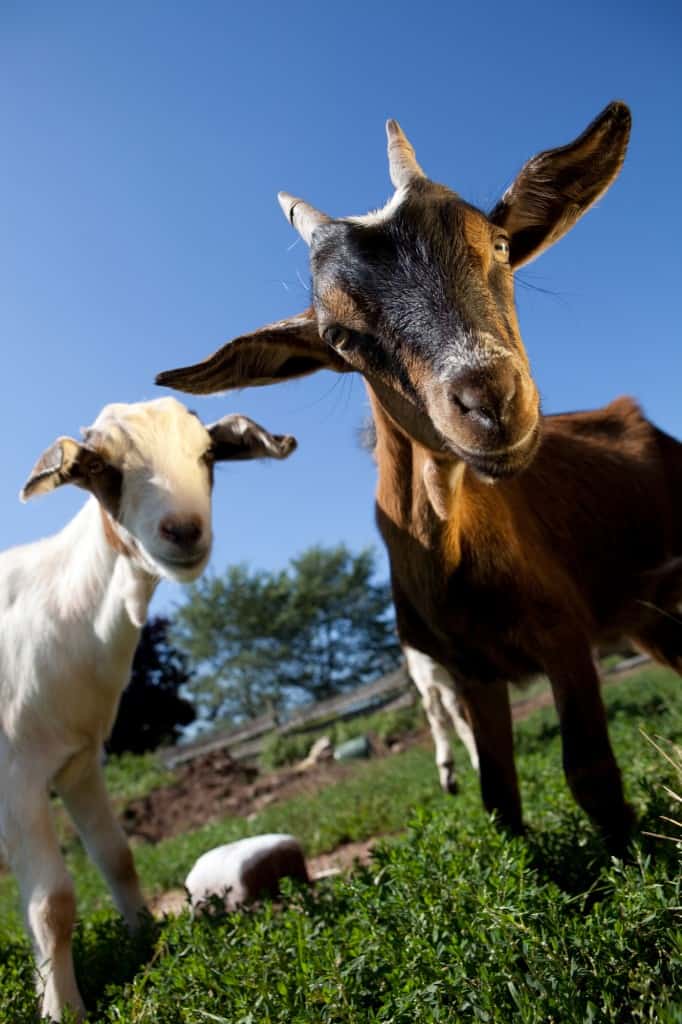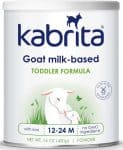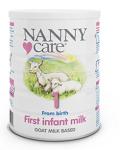And should you switch your baby???
BREAKING NEWS!
In Spring 2023, Kabrita announced they are (finally) releasing the FIRST FDA approved goat milk infant formula … Hooray!!! As of August it’s not available yet, so we haven’t seen the ingredients list. I will update this article when it’s available. It will be wonderful to have a legal goat milk formula available!!!
If you have a baby that has struggled with formula at all – you have likely had someone recommend goat milk formula. It’s all the rage in certain circles. Some of this reputation is well-earned… some is, well … hype.
Goat milk is not a magic pill, but it can be incredibly helpful for specific issues. In this article, I’m going to explain to you what makes goat milk “special” (ie: different) so you know what types of little ones may benefit.
And THEN, I’ll break down the differences in your goat milk formula options (Holle vs Kabrita vs Nanny Care) so that you know which one would be the BEST goat milk formula to start with for your unique baby.
If it’s easier for you to listen to a video on this topic while you simultaneously bounce your baby, make dinner and fold laundry – here is the link to a Happy Hour I did on this very topic – listen away!
Protein:
First (and fairly obviously) goat milk is different than cow’s milk. When it comes to the proteins in each milk – the majority of the proteins are the same. So, if your little one has been diagnosed with a cow’s milk allergy, they CANNOT have goat milk formula either since the chances of them reacting to goat milk protein is crazy high.
However, if your little one’s issues are stemming from a sensitivity to a protein in cow’s milk, then goat milk formula might help. This is because some of the proteins in cow’s milk are unique to cow’s and are not present in goat’s milk (and vice versa). So you may always get lucky and the individual protein in cow’s milk that is making your angel uncomfortable could be missing in goat milk. More likely, there may just be less of it in goat milk so the exposure to the culprit protein is reduced. This is a “talk to your doctor” moment.

Digestion:
This is where the bulk of goat milk “benefits” come from. When goat milk proteins hit the stomach, they produce a smaller and softer curd than cow’s milk proteins, which is more like breast milk curds (1, 2). The curd results from the casein proteins – these are the white chunks that come up in spit up. It’s not hard to imagine how smaller softer “chunks” may move out of the stomach and into those tiny intestines more comfortably.
In addition to this, the digestive system can digest goat milk proteins more quickly, and more completely than cow’s milk proteins (3, 4, 5).
And finally, there was a really cool recent study that showed that the timing of both protein digestion and protein absorption of goat milk infant formula was much closer to breast milk than how cow’s milk infant formula was digested (6).
In all honesty, this body of research doesn’t tell you if more efficient or appropriately-timed digestion results in less discomfort – but we practitioners make that leap for ourselves. It makes sense to me that “better” digestion and absorption may help with less cramping, less gas, and less constipation. If you want to nerd out even more about the biochemical differences between cow vs goat milk, here’s a video that goes into more detail. Your inner nerdling can thank me later.

What Babies May Benefit?
So, now that you know what makes goat vs cow’s milk formulas different – you have an idea of what type of baby issues might be helped by a switch to a goat milk formula.
If your baby has a cow’s milk allergy – goat milk formula will NOT help you.
If you are dealing with more general discomfort that seems to be stemming from digestive issues – maybe all those differences in how goat milk is digested will help your baby feel better after eating. Ask your doc before switching.
What is the BEST Goat Milk Formula out there?
Come on – you know I’m not going to just drop a single brand and say it’s the best. That would be way too easy. There are seceral options available and they each have special characteristics that would be helpful for specific babies.

But the BAD NEWS first:
There are NO US INFANT GOAT MILK FORMULAS on the market. That makes me 55% exasperated and 55% infuriated (yes, I know that adds up to more than 100%. I am a very emotional person!). Sooooo …. If you want to use a goat milk formula, you and your pediatrician have to be willing to use non-conventional options that include certain risks. Your choices are a US toddler formula (Kabrita) or a European infant formula (Nanny Care and Holle).
UPDATE: since the shortage, we have LEGAL goat milk formulas available from Bubs and Kendamil (check out ingredients here). We’ll also have a Kabrita INFANT formula available soon! These are all way better options than using one of the off-label formulas below.
Toddler formulas can really vary in nutrient composition, so it’s important to do your research and have a long talk with your doctor before using a Toddler formula with a baby younger than 12 months. I really don’t recommend it.
And if you decide to go with one of the European brands, you MUST be sure that you are getting it from a reputable source that can ensure you that the formula has been stored appropriately. Just do your research. And lastly, when choosing any European formula, there is always a risk that you will face a shortage at some point, so weigh your options. (And if you want to nerd out on other regulatory differences between US vs European formulas, I break those all down for you here).
Remember, currently you can get LEGAL and SAFE foreign goat milk formula in the US, due to the shortage … a wayyy better option!
Then – make your choice based on the ingredients. Kabrita vs Holle vs Nanny Care each have some different characteristics that set them apart from each other. Here is a summary of the differences in the major ingredients for quick reference.
| Brand | Whey to Casein | Carbohydrate | Fat | Non-Required Extras |
|---|---|---|---|---|
|
Kabrita |
50/50 | 100% Lactose | 40% High 2-Palmitic Acid Oil, 27% Soybean oil, 19% Palm kernel oil, 14% Sunflower oil |
DHA GOS* (a prebiotic) |
|
Holle Stage 1 |
20/80 | 52% Maltodextrin, 48% Lactose | Goat Cream, Palm Oil, Rapeseed Oil, Sunflower Oil | L-tryptophan, L-cystine, L-isoleucine |
| Holle Stage 2 | 20/80 | 47.5% Maltodextrin, 46.2% Lactose, 6.3% Starch | Goat Cream, Palm Oil, Rapeseed Oil, Sunflower Oil | L-tryptophan, L-cystine, L-methionine, L-isoleucine |
|
Nanny Care – Stage 1 |
20/80 | 100% Lactose | Goat Cream, High Oleic Sunflower oil, Rapeseed oil, Sunflower oil | L-tryptophan, L-isoleucine, Taurine, L-carnitine |
|
Nanny Care – Stage 2 |
20/80 | 100% Lactose | Goat Cream, High Oleic Sunflower oil, Rapeseed oil, Sunflower oil | L-tryptophan, L-isoleucine, Taurine |
*Galacto-oligosaccharides
Here are some summary points about each brand:

Kabrita:
This formula is not organic but does meet EU non-GMO standards and their goats are treated very well (in my opinion) which always makes me feel good. The carbohydrate is 100% lactose. Kabrita is different from Holle and Nanny Care in 4 big ways.
1) It’s a toddler formula! If you feed it to a baby under 12 months, you are using it “off label”. Please onlhy make this choice with the support of your pediatrician.
2) Kabrita adds extra whey (goat milk whey) to the formula so you can see the whey/casein ratio is closer to the whey/casein ratio in breast milk. Now almost all the research on whey and casein and digestion is done on cow’s milk, which makes it easy to say that extra whey is better in cow’s milk formula. There is just WAY less research in goat milk formulas, but given the chemical differences between whey and casein, it does make sense to me that extra whey in goat milk formula will be helpful for certain babies.
3) Kabrita uses a special type of palm oil that basically avoids all the negatives of palm oil. This means, no calcium soaps formed in the intestines, and softer stools. So this type of fat blend may be super beneficial and comforting for babies suffering from constipation.

Holle:
This formula is EU organic, and has some really high animal-care standards. Awesome. This is a lactose-reduced formula with roughly 50% of the carbs coming from lactose. So, if you have a gut-feeling that your baby is having trouble with a 100% lactose load, then this may be a good choice. (“gut feeling” … hahaha!)
The other super-cool thing about Holle is that the fat blend includes some goat milk cream. Because the animals are likely better cared for than me on the average Tuesday, this cream will have a very healthy fatty acid composition and natural cholesterol (just like breast milk!). I think this is awesome and can’t wait to see more formulas using high quality cream in their fat blend.
Both Kendamil and Bubs use whole milk goat milk as the base of their goat’s milk infant formula, and you can get these in the US legally (at least for now), so I recommend going with one of these brands instead.

Nanny Care:
Nanny Care (as a company) has been around for ages, and they’re actually the company that invested in the clinical trials necessary to establish the safety of goat milk formula (7, 8), so I give them big kudos for investing in research.
Similar to Kabrita, this formula uses 100% lactose as the carbohydrate. This formula is not organic, but they do take the care and happiness of their goats really seriously. Not only does this make me feel warm and fuzzy, but it’s really critical because they also use some of the goat milk cream in their fat blend. Since the animals are so well fed and cared for, their cream should have the benefits that the Holle cream does.
Lastly, Nanny Care avoids palm oil altogether, which is a big bonus if your baby is suffering from hard stools.
Again, both Kendamil and Bubs use whole milk goat milk as the base of their goat’s milk infant formula, and you can get these in the US legally (at least for now), so I recommend going with one of these brands instead.
That’s it – super simple, right? (*to be said dripping with sarcasm*). It’s not simple.
But I hope that understanding these differences will help you make the best choice for your baby.
It’s actually quite nice to have a couple options to discuss with your doctor, and some legitimate reasons why you may choose one over the other.
As things change in the formula world, I will do my very best to keep this page updated. Right now (in 2023), it’s SO EXCITING to have legal safe goat milk options available, and a US formula on-the-way. Parents have been waiting so long for this. Hooray!
You are doing a great job!
Happy digestion to all,
Dr Young
References
- Park YW. Hypo-allergenic and therapeutic significance of goat milk. Small Rumin. Res. 1994 ;14,151–161.
- Ceballos LS, et al. Utilization of nitrogen and energy from diets containing protein and fat derived from either goat milk or cow milk. J Dairy Res. 2009;4:497-504.
- Almaas H, et al. In vitro digestion of bovine and caprine milk by human gastric and duodenal enzymes. Int Dairy J. 2006;16:961–68.
- Pintado ME, et al. Hydrolysis of ovine, caprine and bovine whey proteins by trypsin and pepsin. Bioprocess Engineering 2000;23:275-282.
- Hodgkinson et al. Gastric digestion of cow and goat milk: Impact of infant and young child in vitro digestion conditions Food Chemistry. 2018; 245: 275-281.
- Maathius et al. Protein digestion and quality of goat and cow milk infant formula and human milk under simulated infant conditions. J Pediatric Gastroenterology and Nutrition. 2017; 6: 661-686.
- Grant et al. Randomized double-blind comparison of growth in infants receiving goat milk formula versus cow milk infant formula. J Paediatr. Child Health. 2005; 41:564-568
- Zhou et al. Nutritional adequacy of goat milk infant formulas for term infants: a double-blind randomised controlled trial. British Journal of Nutrition. 2014; 111:1641-1651.


Leave a Reply